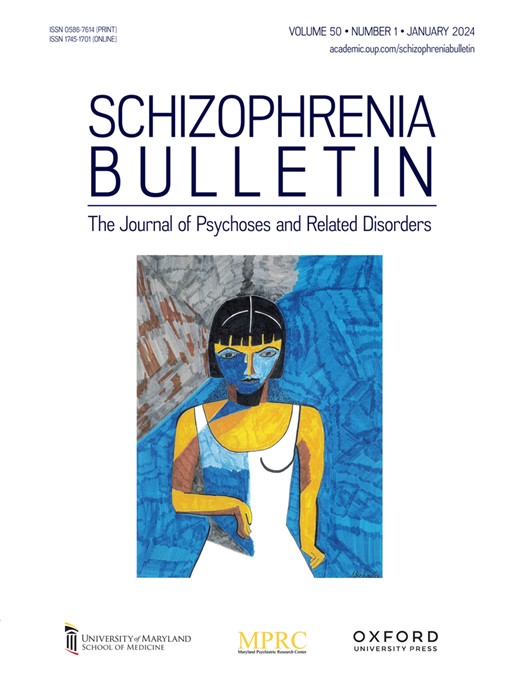临床精神病高危人群凝视知觉任务中的眼动异常:基于隐马尔可夫模型的判别分析
IF 4.8
1区 医学
Q1 PSYCHIATRY
引用次数: 0
摘要
目的社会认知障碍在精神分裂症和临床精神病高危人群中存在。虽然精神分裂症患者在凝视感知过程中存在眼动异常,但对CHR患者的这种理解是有限的。本研究招募了36名CHR个体和50名健康对照者(HC),使用眼动追踪技术进行凝视感知任务,并用隐马尔可夫模型分析其可预测性和模式识别。眼动变量和行为反应、自我参照凝视知觉(SRGP)率在两组之间进行比较,并用判别分析进行检验。眼动和SRGP率与多症状维度和社会功能之间的关系进行了检查。结果与HC相比,CHR组表现为鼻聚焦(眼聚焦)和不稳定的眼动模式。行为变量和眼动变量组合对CHR和HC的区分能力为0.893,显著优于单独使用SRGP率(AUC = 0.824)或眼动变量(AUC = 0.781)的模型。该联合模型具有较高的灵敏度(0.861)和特异性(0.820),其中眼鼻尺度、注视时间和模糊SRGP率是最具鉴别性的特征。自我参照凝视感知率主要与精神分裂型和社交焦虑相关,而眼动模式主要与妄想和社交功能相关。本研究全面考察了CHR患者凝视感知过程中的眼动模式及其与临床表现的关系,提示视觉注意模式在CHR人群中作为诊断生物标志物和治疗靶点的潜力。本文章由计算机程序翻译,如有差异,请以英文原文为准。
Eye Movement Abnormalities During the Gaze Perception Task in Individuals With Clinical High Risk for Psychosis: A Discriminant Analysis With Hidden Markov Models
Objectives Social cognitive impairments were well-documented in schizophrenia and individuals with clinical high risk for psychosis (CHR). While eye movement abnormalities during gaze perception in schizophrenia have been suggested, such understanding in individuals with CHR is limited. Design, Settings and Participants This study recruited 36 CHR individuals and 50 healthy controls (HC) to perform a gaze perception task with eye-tracking techniques analyzed with hidden Markov models for predictability and pattern recognition. Eye movement variables and behavioral responses, self-referential gaze perception (SRGP) rates, were compared between groups and examined with discriminant analyses. Associations between eye movements and SRGP rates with multiple symptom dimensions and social functioning were examined. Results Results indicated that CHR group displayed nose-focused (vs eye-focused) and erratic eye movement patterns compared to HC. The combination of behavioral and eye movement variables exhibited a discriminatory ability of 0.893 area under the curve (AUC) in classifying CHR and HC, significantly outperforming models using either SRGP rates (AUC = 0.824) or eye movement variables (AUC = 0.781) alone. The combined model achieved high sensitivity (0.861) and specificity (0.820), with eyes-nose scale, fixation duration, and ambiguous SRGP rate emerging as the most discriminative features. Self-referential gaze perception rates were primarily associated with schizotypy and social anxiety, while eye movement patterns were mainly associated with delusional ideations and social functioning. Conclusions and Relevance This study comprehensively examined eye movement patterns during gaze perception in CHR and their associations with clinical manifestations, suggesting the potential of visual attention patterns as both diagnostic biomarkers and therapeutic targets in the CHR population.
求助全文
通过发布文献求助,成功后即可免费获取论文全文。
去求助
来源期刊

Schizophrenia Bulletin
医学-精神病学
CiteScore
11.40
自引率
6.10%
发文量
163
审稿时长
4-8 weeks
期刊介绍:
Schizophrenia Bulletin seeks to review recent developments and empirically based hypotheses regarding the etiology and treatment of schizophrenia. We view the field as broad and deep, and will publish new knowledge ranging from the molecular basis to social and cultural factors. We will give new emphasis to translational reports which simultaneously highlight basic neurobiological mechanisms and clinical manifestations. Some of the Bulletin content is invited as special features or manuscripts organized as a theme by special guest editors. Most pages of the Bulletin are devoted to unsolicited manuscripts of high quality that report original data or where we can provide a special venue for a major study or workshop report. Supplement issues are sometimes provided for manuscripts reporting from a recent conference.
 求助内容:
求助内容: 应助结果提醒方式:
应助结果提醒方式:


